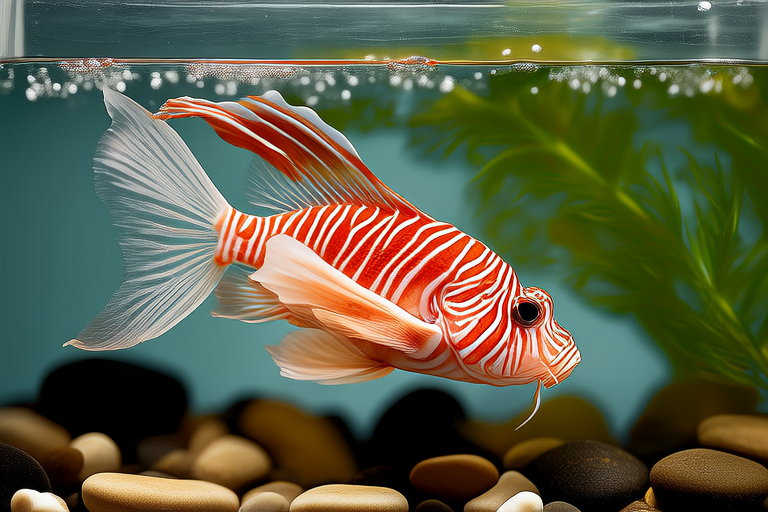
Goldfish Behavior Decoded: What Those Swim Patterns Mean
Goldfish are beloved pets known for their vibrant colors and graceful movements. However, understanding their behavior can sometimes be challenging. This article aims to decode the swim patterns of goldfish, offering insights into their daily activities and potential health concerns. By learning about these behaviors, you’ll be better equipped to provide your goldfish with a nurturing environment.
Understanding Normal Swim Patterns
Surface Swimming
One common behavior observed in goldfish is surface swimming. Goldfish often come up to the top of the tank to gulp air. This action is primarily related to their physiology; they have a labyrinth organ that allows them to breathe atmospheric oxygen. While this behavior is normal, excessive surface swimming could indicate low oxygen levels in the water. Ensuring adequate aeration in the tank is crucial for maintaining a healthy environment.
Bottom Dwelling
Goldfish also exhibit bottom-dwelling behavior. Some species, particularly fancy goldfish, prefer to stay near the bottom of the tank. This preference might be due to their physical structure, which makes it easier for them to navigate the lower areas of the aquarium. Bottom-dwelling can also be a sign of comfort and familiarity with their surroundings. However, if your fish suddenly starts spending more time at the bottom, it could signal health issues such as swim bladder disorder or internal parasites.
Darting Movements
Darting around the tank is another typical behavior. Goldfish can move quickly from one side of the tank to the other, seemingly without a clear direction. These rapid movements are often a display of energy and excitement, especially when they’re chasing food or playing. If your goldfish exhibits frequent darting, ensure there are enough hiding spots and decorations to stimulate their curiosity and prevent boredom.
Circling
Circling the tank is another behavior commonly seen in goldfish. Sometimes, they will swim in circles, possibly out of boredom or to explore their environment. However, if the circling becomes persistent and accompanied by other unusual signs, it may indicate a health issue such as swim bladder disease or stress. Regularly checking water parameters and providing ample space can help mitigate these problems.
Potential Health Issues Indicated by Erratic Swimming
Erratic or unusual swimming patterns can sometimes signal health problems in goldfish. It’s important to monitor your fish closely for any changes in behavior. Here are some conditions that might be indicated by abnormal swim patterns:
- Swim Bladder Disorder: This condition affects the fish’s ability to control its buoyancy. Fish suffering from swim bladder disorder may float upside down, sink to the bottom, or struggle to maintain a vertical position. Proper diet and avoiding overfeeding can help prevent this condition.
- Internal Parasites: Parasites can cause discomfort and lead to erratic swimming. Symptoms may include loss of appetite, lethargy, and discolored fins. Treatment typically involves medication prescribed by a veterinarian.
- Stress: Stress can manifest in various ways, including erratic swimming. Factors contributing to stress include poor water quality, overcrowding, and sudden changes in the environment. Maintaining stable water conditions and providing a peaceful habitat are key to reducing stress.
Goldfish Communication Through Body Language and Tail Movement
Goldfish communicate through a variety of body language and tail movements. Understanding these signals can enhance your interaction with your pet and provide valuable insights into their well-being.
Tail Movements
The tail (caudal fin) plays a significant role in communication. A flick of the tail can indicate excitement or agitation. During feeding times, you might notice your goldfish rapidly wagging their tails, signaling eagerness for food. On the other hand, a slow, deliberate tail movement might suggest relaxation or contentment.
Body Posture
Goldfish also convey messages through their body posture. When they arch their backs, it could be a sign of discomfort or pain, possibly indicating swim bladder issues. Conversely, a relaxed posture with their body straightened out suggests they are feeling comfortable and at ease.
Tips for Maintaining a Healthy Environment
To encourage natural behaviors and promote overall health, it’s essential to create an optimal environment for your goldfish. Here are some tips:
- Adequate Space: Goldfish require plenty of room to swim freely. The general rule is one gallon of water per inch of fish. Providing ample space helps reduce stress and allows for natural swimming patterns.
- Water Quality: Regular water changes and proper filtration are vital for maintaining clean and healthy water. Test the water regularly for ammonia, nitrite, and nitrate levels to ensure they remain within safe ranges.
- Proper Diet: Feeding a balanced diet rich in nutrients supports good health. Offer a variety of foods, including pellets, flakes, and occasional treats like brine shrimp or bloodworms. Avoid overfeeding, as excess food can degrade water quality.
- Hiding Spots and Decorations: Adding plants, rocks, and caves provides hiding spots and enriches the tank’s environment. These features stimulate exploration and play, encouraging natural behaviors.
Conclusion
Decoding the swim patterns of goldfish can significantly enhance your understanding of their needs and well-being. By recognizing normal behaviors such as surface swimming, bottom dwelling, darting movements, and circling, you can better appreciate the unique characteristics of your pet. Meanwhile, being aware of potential health issues indicated by erratic swimming ensures timely intervention. Additionally, observing body language and tail movements offers deeper insights into your goldfish’s communication. By following the tips provided for maintaining a healthy environment, you’ll foster a thriving habitat where your goldfish can thrive naturally. Embrace the joy of owning goldfish and enjoy the fascinating world of their behaviors.






